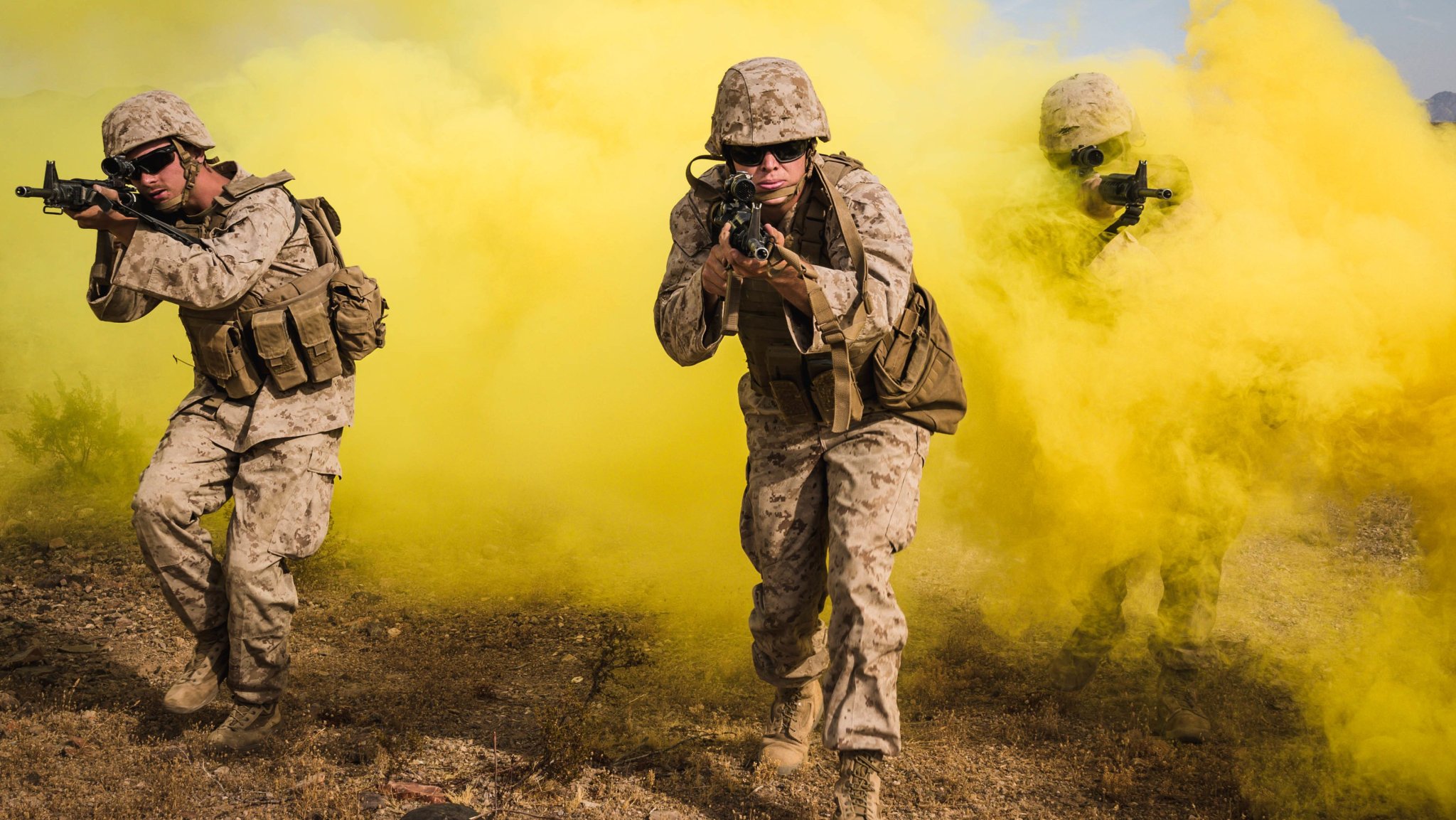
Marines assault through smoke from an M18 grenade. The Army is seeking to buy 65,000 pounds of powdered sugar, a little-known but key ingredient in the widely-used M18. Lance Cpl. Zachary Zephir
A recent Army contracting notice looks at first glance more likely to be from a whimsical chocolate factory than a major weapons arsenal that produces battlefield-ready incendiary munitions. The contract, filed by officials at Pine Bluff Arsenal, Arkansas, which builds munitions for all military branches, is looking for bids on 65,000 pounds of powdered sugar for “grenades and smoke pots, according to federal contracting documents.
It turns out that sweet powdery sugar, the same you might put on funnel cake at a state fair, is a major ingredient to make things go boom, or at least hiss and spray smoke.
The sugar, the documents say, is “in support of the M18 /M83 Grenade Program and M8 Smoke Pot Program,” which are used across all U.S. military branches as smoke grenades. For bakers who might be wondering, the contract allows 6X, 10X or 12X varieties, but prefers it delivered in 50 lbs. bags.
An official with Joint Munitions Command said no experts were available for comment because of the government shutdown. However, getting the actual sugar does apparently transcend politics because the documents insist ”there is no effect on this requirement if there is a government shutdown.”
Though powder sugar’s use in industrial weapons making isn’t an obvious leap of logic, the chemistry is fairly simple, according to an online post by Rick Samples, a former official with the Jacksonville, Florida Sheriff’s Office Bomb-Making Materials Awareness Program and retired special agent and certified explosives specialist with the U.S. Bureau of Alcohol, Tobacco, Firearms and Explosives. Explosives need an oxidizer, ignition source and fuel, and sugar is an excellent fuel.
In fact, Samples wrote, in the 1990s, the Irish Republican Army used icing sugar in its car bombs with “devastating effects.”
 The Army is seeking to buy 65,000 pounds of powdered sugar, a little-known but key ingredient in the widely-used smoke M18 grenade. Senior Airman Joseph Bartoszek
The Army is seeking to buy 65,000 pounds of powdered sugar, a little-known but key ingredient in the widely-used smoke M18 grenade. Senior Airman Joseph BartoszekThe Army’s use of sugar in grenades goes back at least two decades. According to a 2007 release from Picatinny Arsenal in New Jersey, Army scientists turned to sugar as a substitute for sulfur-based fuel as a way to make smoke grenades safer for troops and the surrounding environment.
Task & Purpose spoke with a retired colonel who was an explosive ordnance disposal technician in the Army and now works in a civilian role for one of the services, and an active duty Air Force EOD tech. The two requested anonymity because they were not given permission to talk to the media for a story that gets into the business of homemade explosives.
“You’re basically making a cake, right? You use different ingredients,” the Air Force tech sergeant said after consulting a Defense Intelligence Agency manual on explosives. “You can use sugar in the production as a replacement for sulfur. You just have the type of sugar, white, brown, powdered, whether it’s granulated or fine powdered — it just depends on what their actual objective is.”
Every now and then there are news stories about factory explosions involving saw dust or flour which the colonel said reflects the basic science of just how flammable dust can be.
“A sawdust factory can blow up because you get too much dust in there, and then all of a sudden, there’s a spark, either from one of the machinery or anything, and that spark starts a flame from that powder, and it just transfers across at an expedited rate,” they said.
But just how many grenades and smoke pots could 65,000 pounds of sugar power?
The Air Force sergeant guessed “a metric sh–t ton.”
“I mean, the amount of weight of one of these things is less than a pound, right? If they’re doing a bunch of research and development, they could be trying to do it on a large scale, small scale,” they said. “Honestly, I don’t know, but 65,000 pounds of sugar is a lot.”
Used in smoke grenades to mark or hide positions
According to federal contract documents, the sugar would be used for M83 grenades which are used for training purposes, M18 grenades moreso for operations, and M8 smoke pots.
Ground forces use smoke grenades and smoke pots to create smoke screens for concealment by obscuring forces as they move, or to mark a landing zone for a helicopter. The chemical reaction will produce “a whole bunch of heat” which lights the grenade and releases a smoke signature in a variety of colors like violet, red, yellow or green, the airman said.
Compared to smoke grenades, smoke pots can cover a company, battalion or brigade movement in a larger area like city streets, the retired colonel said. M8 smoke pots in particular can generate smoke screens for nearly five minutes. Smoke pots are typically carried by engineering or Chemical, Biological, Radiological, and Nuclear units.
“Back in the day moving tanks, you put tons of smoke pots out,” they said. “Desert Storm, before we crossed the [sand] berm, we had all the smoke pots out, we set them up and the Iraqis couldn’t see if we’re moving behind the lines.”

Task & Purpose Video
Each week on Tuesdays and Fridays our team will bring you analysis of military tech, tactics, and doctrine.

.jpeg)





















.jpeg)












 English (US) ·
English (US) ·